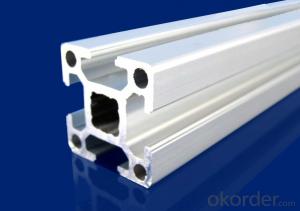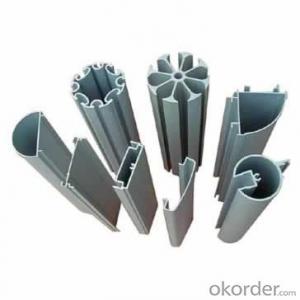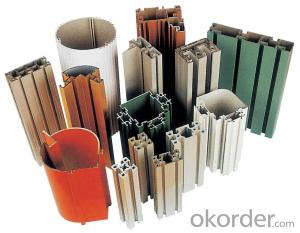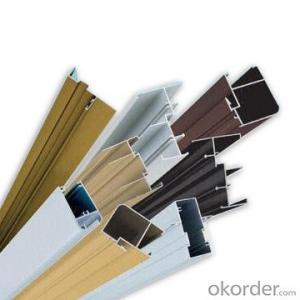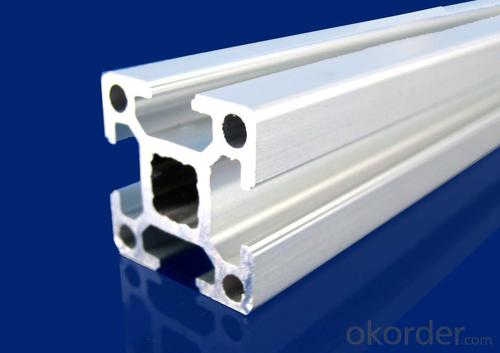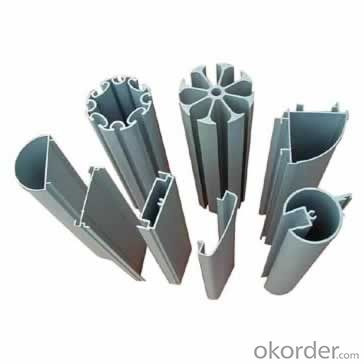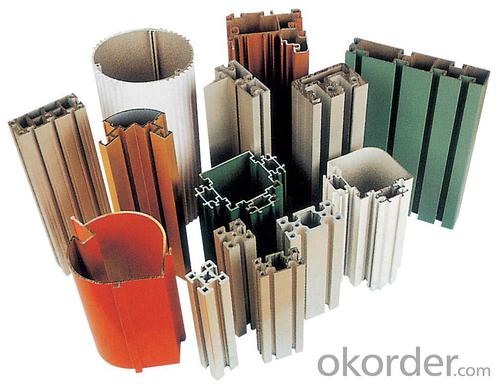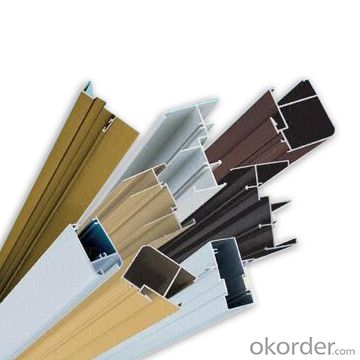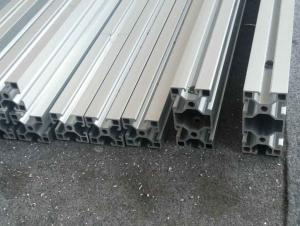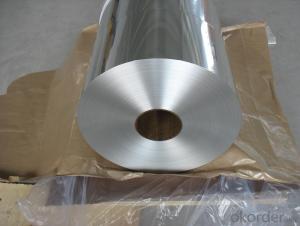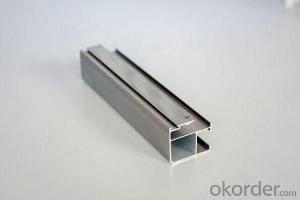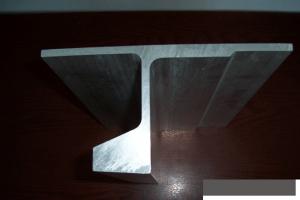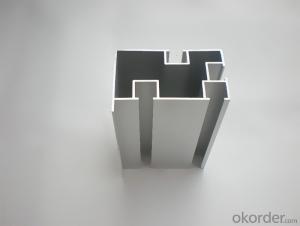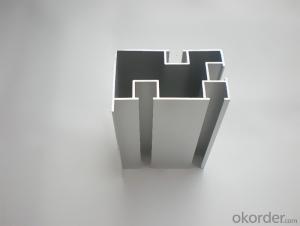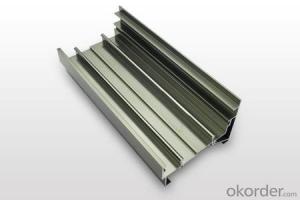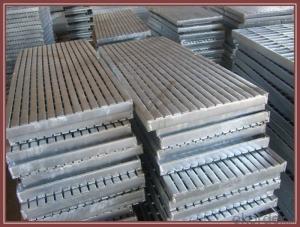Custom Extruded Aluminum Profiles - Alu Profile Extrusion 6063 T6
- Loading Port:
- China Main Port
- Payment Terms:
- TT OR LC
- Min Order Qty:
- -
- Supply Capability:
- -
OKorder Service Pledge
OKorder Financial Service
You Might Also Like
Aluminium is a relatively soft, durable, lightweight, ductileand malleablemetalwith appearance ranging from silvery to dull gray, depending on the surfaceroughness. It is nonmagnetic and does not easily ignite. A fresh film ofaluminium serves as a good reflector (approximately 92%) of visible lightand an excellent reflector (as much as 98%) of medium and far infraredradiation. The yield strength of pure aluminium is 7–11 MPa,while aluminium alloys have yield strengths ranging from200 MPa to 600 MPa. Aluminium has about one-third the densityand stiffness of steel. It is easily machined,cast, drawn and extruded.
Aluminium alloys (or aluminum alloys; see spellingdifferences) are alloysin which aluminium(Al) is the predominant metal. The typical alloying elements are copper, magnesium,manganese,silicon,tin and zinc. There are twoprincipal classifications, namely casting alloys and wrought alloys, both of which are furthersubdivided into the categories heat-treatableand non-heat-treatable. About 85% of aluminium is used for wrought products,for example rolled plate, foils and extrusions.Cast aluminium alloys yield cost-effective products due to the low meltingpoint, although they generally have lower tensile strengthsthan wrought alloys. The most important cast aluminium alloy system is Al–Si,where the high levels of silicon (4.0–13%) contribute to give good castingcharacteristics. Aluminium alloys are widely used in engineering structures andcomponents where light weight or corrosion resistance is required
Features:
Material | Alloy 6063,6061,6005or according to customer’s choice |
Temper | T3, T4, T5, T6 |
Surface | Anodize, electrophoresis, powder coating, PVDF coating, wood grain painting, matted, etc. |
Length | Coating 6.5 meters, Anodizing 6.5 meters, Mill finish 5 meters |
Application | Industrial, electrical equipment(TV set, air conditioner, refrigerator, computer), decoration,construction, transportation |
Custom Made | We can package following with customer's request. |
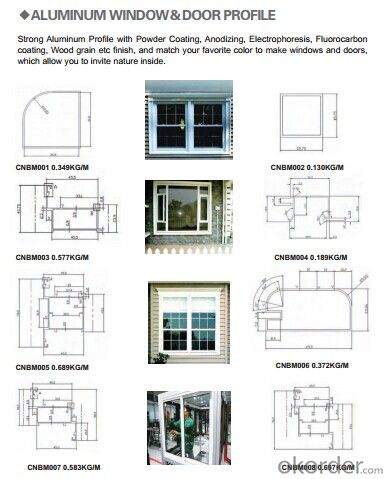
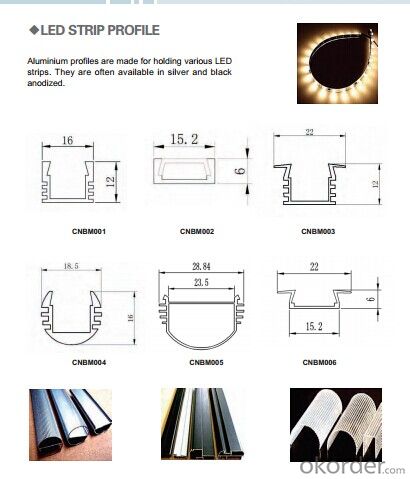
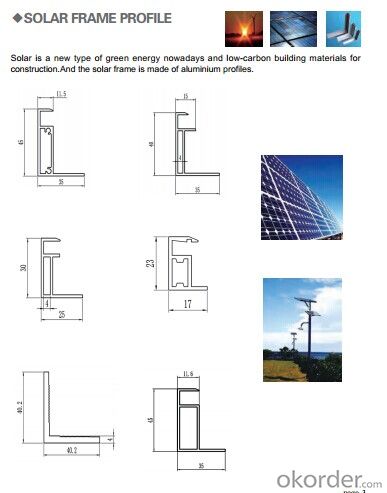
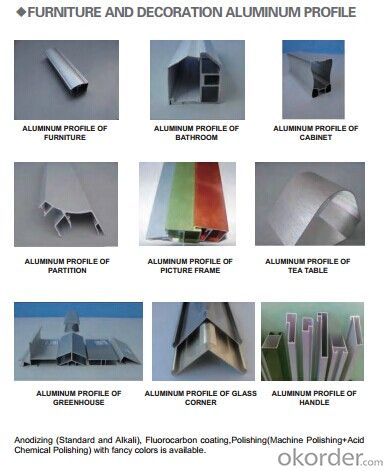
FAQ:
1. What is the form of payment?
Normally 30% TT, L/C at sight
2. Type of quotation?
FOB, CFR, CIF
3. Port of loading?
Shenzhen/Guangzhou port
4. Delivery time?
15-20 days after client’s deposit
- Q: How strong are aluminum profiles?
- Aluminum profiles are known for their exceptional strength-to-weight ratio, making them quite strong despite their lightweight nature. They can withstand various loads and stresses, making them suitable for a wide range of applications, including construction, aerospace, automotive, and industrial sectors. Additionally, aluminum profiles can be reinforced or combined with other materials to further enhance their strength and durability.
- Q: This question asks whether aluminum profiles can be joined using welding or bolting methods.
- <p>Yes, aluminum profiles can be both welded and bolted together. Welding aluminum requires specific techniques and equipment due to its high thermal conductivity, but it is possible and results in a strong joint. Bolting is a common method for joining aluminum profiles, as it is quick, easy, and does not require melting the material. It is important to use appropriate hardware and techniques to ensure a secure and durable connection.</p>
- Q: Can aluminum profiles be used in the construction of modular healthcare facilities?
- Yes, aluminum profiles can be used in the construction of modular healthcare facilities. Aluminum profiles are lightweight, durable, and corrosion-resistant, making them suitable for modular construction. They can be easily assembled, disassembled, and reconfigured, allowing for flexibility in the layout and design of healthcare facilities. Additionally, aluminum profiles can be powder-coated to provide a clean and hygienic surface, which is essential for healthcare environments.
- Q: How do aluminum profiles contribute to energy-saving initiatives?
- There are several reasons why aluminum profiles play a significant role in promoting energy-saving initiatives. Firstly, due to its lightweight nature, aluminum requires less energy for transportation and installation compared to heavier construction materials. This results in a lower carbon footprint during the construction process. In addition, aluminum profiles have excellent thermal conductivity properties, allowing for efficient heat transfer. This is crucial for energy-saving initiatives. When used in windows, doors, and facades, aluminum profiles improve insulation and reduce thermal bridging. As a result, buildings can maintain a comfortable indoor temperature without excessive heating or cooling, leading to reduced energy consumption. Furthermore, aluminum profiles can be effectively combined with energy-efficient glazing systems. These systems, such as double or triple glazing and low-E coatings, enhance the thermal performance of windows and facades. By using aluminum profiles alongside energy-efficient glazing, buildings can significantly reduce heat loss or gain, resulting in lower energy usage for heating and cooling. Moreover, aluminum is a highly durable and long-lasting material. Its corrosion resistance properties make it suitable for use in various weather conditions, reducing the need for frequent replacements. This durability ensures that the energy-saving benefits provided by aluminum profiles are maintained over an extended period, minimizing the environmental impact associated with frequent material replacements. Lastly, aluminum is a recyclable material with a high recycling rate. The energy required to recycle aluminum is significantly lower compared to the energy needed for primary production. By promoting the use of aluminum profiles, we encourage the recycling and reuse of this material, reducing the demand for new aluminum production and conserving energy resources. In conclusion, aluminum profiles contribute to energy-saving initiatives by reducing transportation and installation energy consumption, improving thermal insulation, facilitating energy-efficient glazing systems, providing durability, and promoting recycling. By incorporating aluminum profiles in construction projects, we can make a significant contribution to energy conservation and sustainability efforts.
- Q: Is it possible to utilize aluminum profiles for constructing exterior railings and staircases?
- <p>Yes, aluminum profiles can be used for exterior railings and staircases. They are known for their durability, resistance to corrosion, and low maintenance requirements, making them ideal for outdoor applications. Aluminum's strength and lightweight properties also contribute to its suitability for these structures. However, it's important to ensure that the aluminum is of high quality and properly treated to withstand weather conditions and ensure longevity.</p>
- Q: Are aluminum profiles suitable for industrial workstations?
- Yes, aluminum profiles are suitable for industrial workstations. Aluminum is a lightweight and durable material that offers excellent strength-to-weight ratio, corrosion resistance, and thermal conductivity. It is easy to work with and allows for flexibility in design, making it suitable for various industrial applications. Additionally, aluminum profiles can be easily customized and adapted to meet specific workstation requirements, making them a popular choice in industrial settings.
- Q: How to calculate the spraying powder of aluminium profile?
- If you are oily and material surface oxidation layer, the most complete process is: in addition to the principle of oil - water - rust - powder coating construction technology and requirement of the powder electrostatic spraying is the use of high-voltage corona electrostatic electric field. stay
- Q: What are the noise insulation properties of aluminum profiles?
- Aluminum profiles have good noise insulation properties due to their density and ability to dampen sound vibrations. They can effectively reduce external noise and provide a quieter indoor environment.
- Q: Why should aluminum surface treatment process?
- In order to strengthen the performance of aluminum material.Anodizing, passivation, electroplating, spraying, and some other surface treatment processes are designed to "resist corrosion" and allow aluminum to last longer without oxidation.
- Q: 30*40 how much aluminum meter?
- 3040 aluminum price, looking for Shanghai Bei pie. Aluminum specifications are complete, the corresponding parts are.
Send your message to us
Custom Extruded Aluminum Profiles - Alu Profile Extrusion 6063 T6
- Loading Port:
- China Main Port
- Payment Terms:
- TT OR LC
- Min Order Qty:
- -
- Supply Capability:
- -
OKorder Service Pledge
OKorder Financial Service
Similar products
Hot products
Hot Searches
Related keywords
